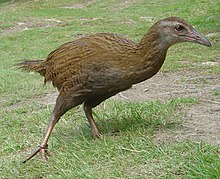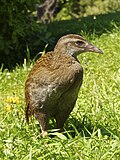Gallirallus is a genus of rails that live in the Australasian-Pacific region. The genus is characterised by an ability to colonise relatively small and isolated islands and thereafter to evolve flightless forms, many of which became extinct following Polynesian settlement.
| Gallirallus | |
|---|---|
 | |
| Weka, Gallirallus australis | |
| Scientific classification | |
| Domain: | Eukaryota |
| Kingdom: | Animalia |
| Phylum: | Chordata |
| Class: | Aves |
| Order: | Gruiformes |
| Family: | Rallidae |
| Genus: | Gallirallus Lafresnaye, 1841 |
| Species | |
1 living, and see text | |
Taxonomy
Following recent taxonomic revisions, there is only one known extant species in this genus along with several extinct species of dubious classification, with all other species being moved to Hypotaenidia, Cabalus, Lewinia, or Aptenorallus.[1]
Description
Many of the rails, including the well-known weka of New Zealand, are flightless or nearly so.Many of the resultant flightless island endemics became extinct after the arrival of humans, which hunted these birds for food, introduced novel predators like rats, dogs or pigs, and upset the local ecosystems. A common Polynesian name of these rails, mainly relatives of G. philippensis, is veka/weka (in English, this name is generally limited to Gallirallus australis).
On the other hand, Gallirallus species are (with the exception of the weka) notoriously retiring and shy birds with often drab coloration.
Living and recently extinct species
In the online list maintained by Frank Gill, Pamela Rasmussen and David Donsker on behalf of the International Ornithological Committee (IOC), the genus contains only one extant species:[1]
| Image | Scientific name | Common name | Distribution |
|---|---|---|---|
 | Weka | Gallirallus australis | New Zealand |
These species were placed by BirdLife International and IUCN in the separate genus Hypotaenidia, but are still considered part of Gallirallus by The Clements Checklist of Birds of the World / eBird:
- Okinawa rail, Gallirallus okinawae
- Barred rail, Gallirallus torquatus
- Pink-legged rail, Gallirallus insignis
- Roviana rail, Gallirallus rovianae
- Guam rail, Gallirallus owstoni – extinct in the wild (late 1980s)
- Lord Howe woodhen, Gallirallus sylvestris
- Buff-banded rail, Gallirallus philippensis
- Dieffenbach's rail, Gallirallus dieffenbachii – extinct (mid-19th century)
- Wake Island rail, Gallirallus wakensis – extinct (1945)
- Tahiti rail, Gallirallus pacificus – extinct (late 18th – 19th century)
The Calayan rail (formerly Gallirallus calayanensis) was placed into the genus Aptenorallus in 2021.[2]
Species extinct before A.D. 1500

Aside from the weka, all species classified in the genus Gallirallus are only known from subfossil remains, having gone extinct in the Quaternary extinction event. Given the recent taxonomic changes that have led to the weka being the only remaining Gallirallus species, it is possible these may also belong to different genera, but are presently retained in Gallirallus due to uncertainty.[3]
- Astolfo's rail, Gallirallus astolfoi[3]
- Nuku Hiva rail, Gallirallus epulare[4]
- New Ireland rail, Gallirallus ernstmayri
- Ua Huka rail, Gallirallus gracilitibia[4]
- Niue rail, Gallirallus huiatua [5][6]
- Tinian rail, Gallirallus pendiculentus
- Aguiguan rail, Gallirallus pisonii
- Mangaia rail, Gallirallus ripleyi[7]
- Tahuata rail, Gallirallus roletti[4]
- Tubuai rail, Gallirallus steadmani[8]
- Huahine rail, Gallirallus storrsolsoni
- Rota rail, Gallirallus temptatus
- ʻEua rail, Gallirallus vekamatolu – possibly survived to the early 19th century[9][10]
- Hiva Oa rail, ?Gallirallus sp.
- Norfolk Island rail, Gallirallus sp. - possibly survived to the early 19th century[11]
- Vava'u rail, Gallirallus [Hypotaenidia] vavauensis Worthy & Burley 2020[12]
References
External links
 Media related to Gallirallus at Wikimedia Commons
Media related to Gallirallus at Wikimedia Commons Data related to Gallirallus at Wikispecies
Data related to Gallirallus at Wikispecies

